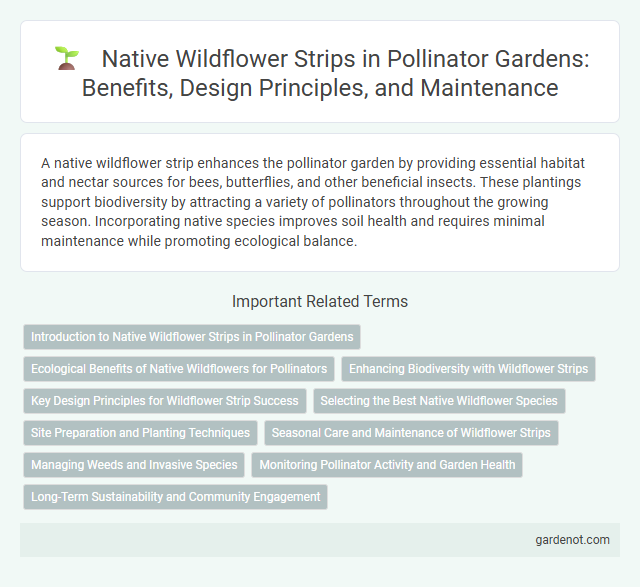A native wildflower strip enhances the pollinator garden by providing essential habitat and nectar sources for bees, butterflies, and other beneficial insects. These plantings support biodiversity by attracting a variety of pollinators throughout the growing season. Incorporating native species improves soil health and requires minimal maintenance while promoting ecological balance.
Introduction to Native Wildflower Strips in Pollinator Gardens
Native wildflower strips provide essential habitat and food sources for pollinators such as bees, butterflies, and hummingbirds. These strips enhance biodiversity by supporting a variety of native plant species adapted to local ecosystems. Incorporating native wildflower strips in pollinator gardens boosts ecosystem health, improves pollination rates, and fosters sustainable wildlife populations.
Ecological Benefits of Native Wildflowers for Pollinators
Native wildflower strips provide essential habitats that support the lifecycle of pollinators such as bees, butterflies, and hummingbirds by offering diverse nectar and pollen sources throughout the growing season. These wildflowers enhance local biodiversity and improve ecosystem resilience by sustaining native pollinator populations that, in turn, increase pollination efficiency for surrounding crops and plants. Their deep root systems also prevent soil erosion and promote nutrient cycling, contributing to healthier, more sustainable environments favorable to pollinator survival.
Enhancing Biodiversity with Wildflower Strips
Native wildflower strips play a vital role in enhancing biodiversity by providing essential habitats for pollinators such as bees, butterflies, and birds. These strips support diverse plant species that supply continuous nectar and pollen sources throughout the growing season, promoting healthy pollinator populations. Implementing native wildflower strips contributes to ecosystem resilience, improving soil health and supporting beneficial insects that control pests naturally.
Key Design Principles for Wildflower Strip Success
A native wildflower strip thrives by prioritizing site-specific plant selection, ensuring species compatibility with local soil, climate, and pollinator species for optimal growth and attraction. Incorporate plant diversity with staggered bloom times to provide continuous forage, supporting a broad range of pollinators throughout the growing season. Regular maintenance practices like minimal mowing and invasive species control sustain habitat health and promote long-term wildflower strip success in pollinator gardens.
Selecting the Best Native Wildflower Species
Selecting the best native wildflower species for a pollinator garden involves prioritizing plants that bloom at different times to provide continuous nectar and pollen sources for various pollinators like bees, butterflies, and hummingbirds. Opt for species well-adapted to local soil, climate, and moisture conditions, ensuring robust growth and resilience against pests and diseases. Incorporating diverse native wildflowers such as Echinacea purpurea, Asclepias tuberosa, and Solidago canadensis maximizes ecological benefits and supports native pollinator populations effectively.
Site Preparation and Planting Techniques
Effective site preparation for a native wildflower strip involves removing existing vegetation and loosening the soil to enhance root penetration and water retention. Selecting a diverse mix of native wildflower seeds tailored to the local climate and soil conditions ensures optimal pollinator attraction and biodiversity. Planting techniques such as broadcasting seeds followed by light raking or rolling improve seed-to-soil contact, essential for successful germination and establishment.
Seasonal Care and Maintenance of Wildflower Strips
Seasonal care of native wildflower strips involves timely mowing, controlled watering, and weed management to support pollinator habitats throughout the year. In spring, remove debris and selectively thin plants to promote healthy growth, while summer requires monitoring for pests and ensuring adequate irrigation during dry periods. Fall maintenance includes cutting back spent flowers to encourage seed dispersal and protecting root systems during winter dormancy to sustain biodiversity and ecosystem resilience.
Managing Weeds and Invasive Species
Managing weeds and invasive species in a native wildflower strip is crucial for promoting pollinator health and biodiversity. Regular monitoring and targeted removal methods, such as hand-pulling or spot herbicide applications, help preserve native plant dominance and prevent competition. Maintaining soil health and mulching around native wildflowers suppresses invasive growth, supporting a thriving pollinator garden ecosystem.
Monitoring Pollinator Activity and Garden Health
Native wildflower strips foster essential habitats that support diverse pollinator species, enhancing biodiversity and ecosystem resilience. Regular monitoring of pollinator activity, including bee frequency and butterfly visits, provides valuable insights into the garden's health and flowering success. Tracking plant vigor alongside pollinator presence enables timely interventions to sustain optimal conditions for native pollinators.
Long-Term Sustainability and Community Engagement
Native wildflower strips support long-term sustainability by enhancing biodiversity and providing essential habitats for pollinators like bees and butterflies. These strips require minimal maintenance and adapt to local soil and climate conditions, reducing the need for chemical inputs and irrigation. Community engagement through planting events and educational programs fosters stewardship and raises awareness about pollinator conservation benefits.
Native wildflower strip Infographic

 gardenot.com
gardenot.com